AOC i2353Ph - IPS for a nice, low price
by Chris Heinonen on January 30, 2012 12:40 AM ESTCalibration and Results
Of course, once we use ColorEyes Display Pro to calibrate the AOC, we would expect even better results than we got out of the box. As usual, we set a white point target of D65, a gamma of 2.2, minimum black level, and a white level of 200 nits. I then checked the quality of the calibration using the Gretag Macbeth color checker chart. Often you will see display reviews that use the calibration target points to see the quality of the calibration. That gives you a good indicator of how well the software and hardware was able to hit those targets, but unfortunately no idea if only those targets improved, or if other colors were improved as well. Using the Gretag Macbeth swatches, which are designed to mimic common colors in the real world, gives you a better idea of the overall quality of the calibration instead of the quality of those specific targets.
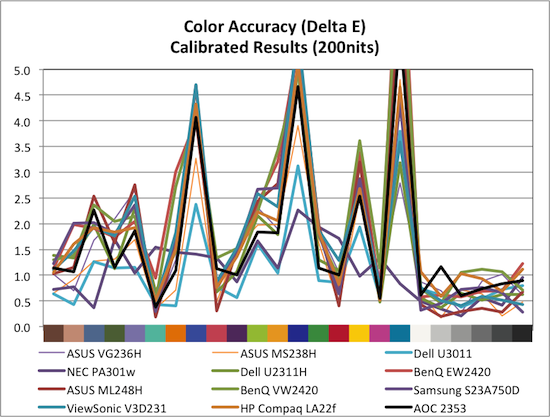
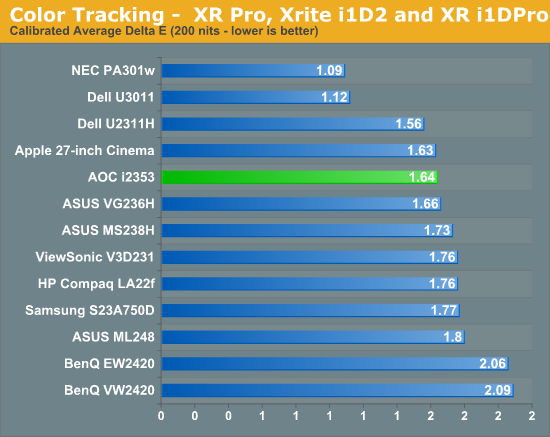
Here we see that the AOC calibrated down to an average dE of 1.64, which is pretty common. When I looked at the results some more, I got a little curious and also decided to see what the median color error was for all the displays. The Gretag Macbeth color checker includes some shades of blue that are at the very edge of the sRGB colorspace, or totally out of it in the case of one sample. In these cases if the display can’t reproduce those shades, the average dE for it might be thrown way off, but the median dE could still be very low since it does a very good job with the colors it can reproduce.
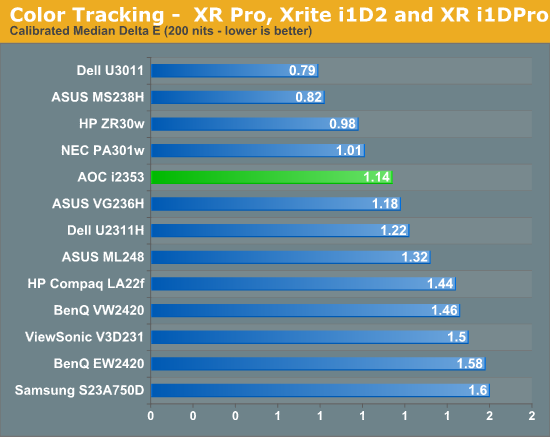
Looking at the results, we can see that the AOC has a much lower median dE than some monitors that produce a lower average dE. When we get to the color gamut data later in the review, we will see that the AOC has a smaller than average gamut, which is leading it to have larger than average errors for color samples on the edge of the sRGB colorspace. In effect, the conclusion we can pull from this is that the AOC can’t produce as many colors as other reviewed displays, but for those that it can produce it does so more accurately. Results like this are why you can’t just look at a lower dE and assume that a display will automatically be better than another display with a higher dE, as it’s just a single number that only tells part of the story.
For people that might use the AOC for press work, or prefer a dimmer display in a dark room like myself, I also calibrated the display to 100 nits of brightness and then took another set of readings.
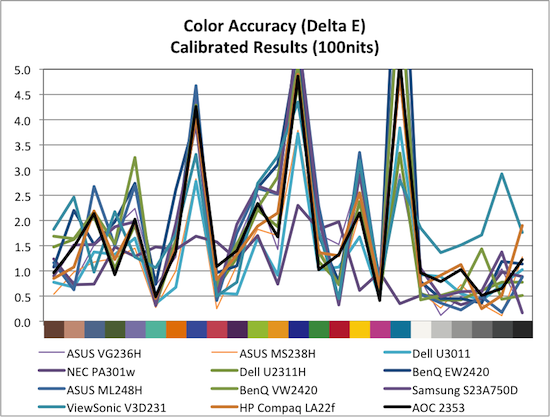
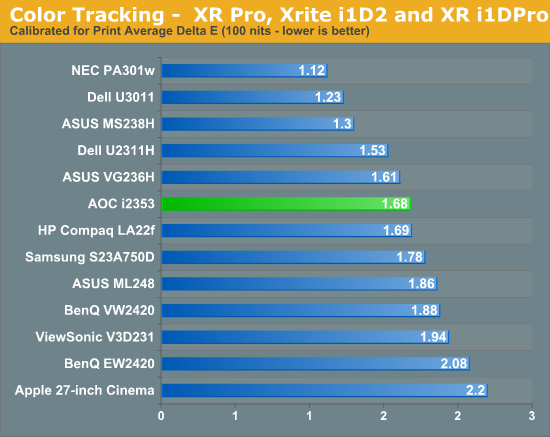
The numbers for 100 nits are almost identical to those for 200 nits. The grayscale is good, and the large errors are all contained in shades of blue, as we would expect.










71 Comments
View All Comments
cheinonen - Monday, January 30, 2012 - link
There are 120Hz TN displays available now, and we recently reviewed one from Samsung which you can find. With gaming, I found the 120Hz refresh to be really nice and make a noticeable difference in how smooth the image was compared to 60Hz. There are no IPS panels available that do 120Hz that I know of, but since you can get 120Hz HDTVs that use IPS panels (they don't accept 120Hz signals, but can display 720p60 frame packed, which is basically 120Hz by a different name) I'd hope that desktop displays using this aren't far away.Do people think that 1 frame of lag is the acceptable cut-off point then? Since there are displays that can do 10ms or less, I tend to think that we should aim for > 0.5 frames of lag as an ideal, but that's also harder to find. I play some games, but I'm not good at FPS games anymore, so my saying that I found 1 frame of lag acceptable is much different than someone who is actually good finding that acceptable.
vailr - Monday, January 30, 2012 - link
What about OLED monitors? I heard that OLED TV's were seen at CES in Las Vegas a few weeks ago, but nothing mentioned about OLED PC monitors.jesh462 - Monday, January 30, 2012 - link
If you get a higher quality panel (Dell/NEC) display port lets you reach over 80hz refresh rates with some tweaks. It's not 120hz. It's also not a dirty TN panel.As for OLED, I believe it's a lost cause for desktop/laptop monitors. Manufacturers are already switching to Quantom Dot technology for production *this year*.
annnonymouscoward - Monday, January 30, 2012 - link
> Do people think that 1 frame of lag is the acceptable cut-off point then?I'm extremely sensitive to lag--so much that I'm turned off from every Droid phone I've ever used. And I've owned a 3007WFP-HC for years, which averages 11.5ms of lag according to digitalversus. I've never perceived lag on it, and I play FPS. I'd never buy a monitor with 30ms lag. The general public can't notice 50ms lag.
I find 60Hz to be the huge limiting factor in FPS's, since getting an update every 16.7ms isn't enough information when trying to target on the fly.
I think there's a sizable market for premium new displays, if some company would have the sense to make them. Instead, all we get is crap. They take monitor tech we've had for 6 years, reduce 3", make it 16:9, and maybe even glossy. There has been virtually zero improvement to the 30" IPS models that came out 6 years ago. I want a 36", X-IPS, WUVDIQXGA, with a polarizer filer, 80Hz minimum. No more 16:9 60Hz garbage.
jaydee - Monday, January 30, 2012 - link
If they could have squeezed in a DisplayPort and 1920x1200 res for just 20-30 more, this would be a great deal IMO. It's a good deal as it is, I was hoping for just a little bit more.CZroe - Monday, January 30, 2012 - link
Shouldn't the freakin' size be in the title, synopsis, or the first paragraph of the article?!TerdFerguson - Monday, January 30, 2012 - link
Great review. Thanks for the info.jleach1 - Tuesday, January 31, 2012 - link
I've been ogling IPS displays for years, but always walked away with one thing in mind...sticker shock!Can you Anandtech staff and the readers recommend an IPS display for the budget-conscious? I understand they're going to be more expensive than their run-of-the-mill partners, but I'm speaking in relative terms.
It wouldn't be for professional use, but rather gaming and video goodness!
Preferably something between 23-25 inches.
Thanks!
J
sviola - Tuesday, January 31, 2012 - link
Hey Chris,Can you guys get in touch with LG and do a review of their new 120Hz IPS monitors due to market this February. The series are the DM92 (27") and the DM82 (23").
Many Thanks
cheinonen - Wednesday, February 1, 2012 - link
These aren't 120 Hz IPS displays. They use circular polarization, much like the Viewsonic monitor we recently reviewed, so each eye gets a 1920x540 image when running at 60Hz. If they were 120Hz we would certainly be interested, but it looks to be a passive 3D display, albeit with IPS instead of TN.